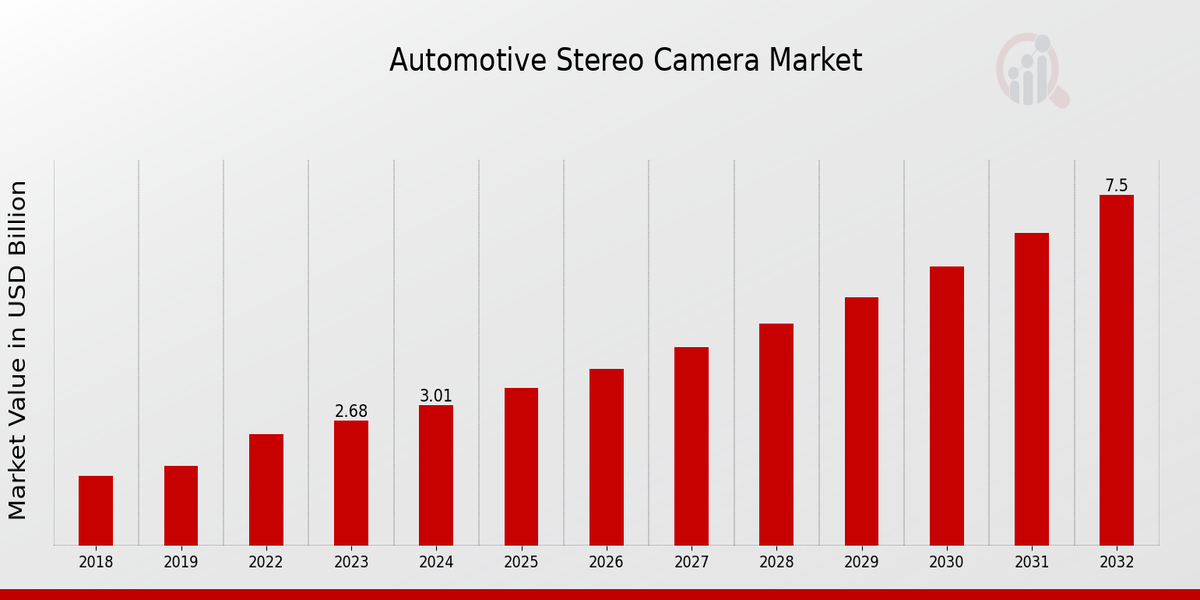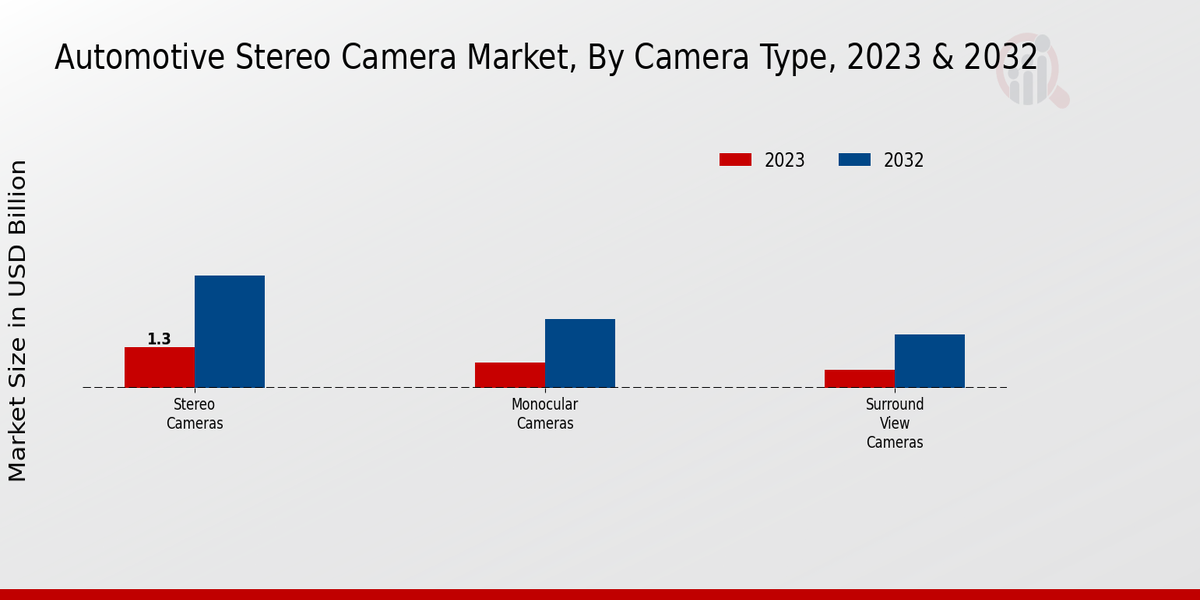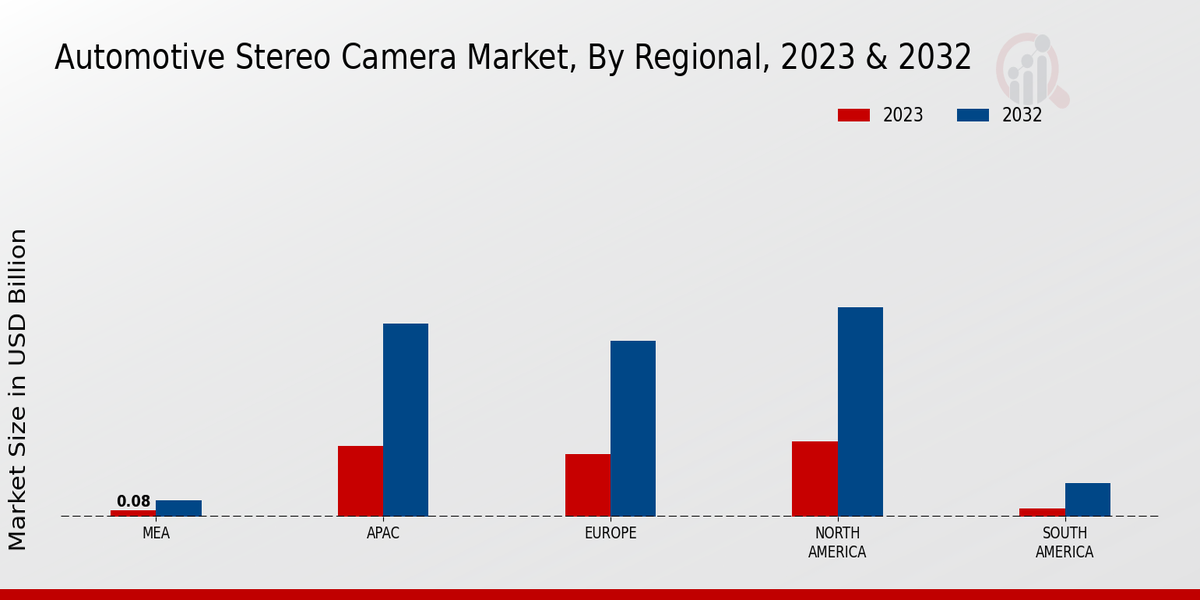Automotive Stereo Camera Market Overview
As per MRFR analysis, the Automotive Stereo Camera Market Size was estimated at 2.39 (USD Billion) in 2022. The Automotive Stereo Camera Market is expected to grow from 2.68 (USD Billion) in 2023 to 7.5 (USD Billion) by 2032. The Automotive Stereo Camera Market CAGR (growth rate) is expected to be around 12.09% during the forecast period (2024 - 2032).
Key Automotive Stereo Camera Market Trends Highlighted
The growing need for improved car safety features and advanced driver assistance systems (ADAS) is the main factor propelling the automotive stereo camera market.
Because safety and convenience are becoming more and more important to consumers, automakers are implementing advanced stereo camera systems that provide better perception and object identification capabilities.
The necessity for dependable sensing technology has increased due to the rapid development of electric and driverless vehicles; stereo cameras are essential for enabling features like collision avoidance and lane-keeping assistance. Government laws that support car safety requirements are also driving investments in stereo camera technology and expanding the market.
There are plenty of opportunities to investigate in the field of automobile stereo cameras, especially with the incorporation of machine learning and artificial intelligence. These technologies have the potential to greatly improve image processing capabilities, which will increase object detection and categorization accuracy.
As automakers focus on creating smarter, more intuitive vehicles, the potential for stereo cameras in applications such as augmented reality and enhanced navigation systems is increasingly evident.
Furthermore, the development of cost-effective manufacturing methods presents opportunities for wider implementation across various vehicle categories, including mid-range and compact cars, which were traditionally less equipped with advanced camera systems.
Recent trends include the rapid advancement of imaging technology, enabling higher resolution and better performance in diverse environments. Innovation in miniaturization processes is also notable, allowing for compact designs that do not compromise functionality.
The growing trend toward connectivity and integration within vehicles is paving the way for stereo cameras to work in conjunction with other sensors, creating a more cohesive automotive ecosystem.
As manufacturers strive to stay competitive, there is a clear movement towards adopting a more collaborative approach between technology providers and automotive companies, ensuring that the development of stereo camera solutions keeps pace with the evolving demands of the market.

Source: Primary Research, Secondary Research, MRFR Database and Analyst Review
Automotive Stereo Camera Market Drivers
Technological Advancements in Automotive Safety Features
The demand for enhanced safety features in vehicles has been a significant driver in the Automotive Stereo Camera Market. As technology continues to evolve, automotive manufacturers are increasingly integrating stereo cameras into their vehicle systems to improve safety and driving assistance features. These advanced systems offer better depth perception and object detection capabilities, which significantly reduce the chances of accidents.
With the increasing awareness of road safety and stringent regulations imposed by governments regarding vehicle safety standards, automakers are compelled to adopt these innovative technologies rapidly. Additionally, the push towards autonomous driving is further fueling investments in stereo camera technology, as these systems are crucial for providing the detailed environmental perception that autonomous vehicles require.
With the expected growing market valuation over the next few years, it is evident that the integration of stereo cameras will not only redefine safety standards but also enhance overall vehicle performance.
The Automotive Stereo Camera Market is witnessing an upswing in research and development activities aimed at improving the effectiveness and efficiency of stereo camera systems, which, in turn, supports the industry's growth trajectory.
Rising Demand for Advanced Driver-Assistance Systems (ADAS)
The increasing adoption of Advanced Driver-Assistance Systems (ADAS) is another critical driver in the Automotive Stereo Camera Market.
Consumers are showing a growing preference for vehicles equipped with smart and autonomous driving features that enhance safety and driving comfort. As these systems rely heavily on efficient sensor data, the integration of stereo cameras is necessary for achieving accurate object detection and recognition.
The rise of ADAS has been accompanied by significant investments from automobile manufacturers aimed at developing advanced systems that contribute to safe and smooth driving experiences.
Growing Awareness of Traffic Safety and Regulations
There is a rising consciousness regarding traffic safety and adherence to regulations worldwide. Governments are implementing strict safety regulations that encourage the integration of advanced technologies in vehicles, including stereo cameras.
This regulatory landscape not only enhances consumer confidence in vehicle safety but also drives automakers to invest in the Automotive Stereo Camera Market. Meeting regulatory compliance while fostering safety innovations represents a strategic growth opportunity in this market.
Automotive Stereo Camera Market Segment Insights
Automotive Stereo Camera Market Camera Type Insights
The Automotive Stereo Camera Market witnessed a significant increase in value driven by the growing demand for advanced driver assistance systems (ADAS) and enhanced safety features in vehicles.
Among various categories under the Camera Type segment, Stereo Cameras demonstrated a dominant presence, with a valuation of 1.3 USD Billion in 2023 and expected to rise to 3.6 USD Billion in 2032. This segment's major holding can be attributed to its ability to provide depth perception and improved object recognition capabilities, essential for features like automatic emergency braking and lane-keeping assistance, thereby enhancing vehicle safety and driver confidence.
The Monocular Cameras market followed, with a valuation of 0.8 USD Billion in 2023, expected to expand to 2.2 USD Billion in 2032. Monocular Cameras were significant due to their cost-effectiveness and simplicity, making them a preferred choice for entry-level vehicles that require basic safety features without the complexity of stereo vision.
Lastly, Surround View Cameras held a smaller but growing share of the market, valued at 0.58 USD Billion in 2023 and projected to reach 1.7 USD Billion by 2032. This segment, while less dominant, was increasingly important for improving parking and low-speed maneuvers, providing drivers with a comprehensive view of their surroundings to prevent accidents.
The overall trends in the Automotive Stereo Camera Market suggested a strong push towards integrating multiple camera types to enhance vehicle functionality, reflecting an evolving landscape where safety and convenience are paramount.

Source: Primary Research, Secondary Research, MRFR Database and Analyst Review
Automotive Stereo Camera Market Application Insights
The Applications within this market, particularly Advanced Driver Assistance Systems (ADAS) and Autonomous Vehicles, hold significant importance, addressing safety and efficiency in driving experiences. ADAS is characterized by its ability to enhance navigation and vehicle control, thereby capturing a major share of the market due to increased demand for safety features.
Meanwhile, the rise of Autonomous Vehicles fosters dependency on accurate stereo vision systems, driving considerable investment and innovation in this area. In addition, Parking Assistance systems benefit from stereo cameras, improving spatial awareness and maneuverability for drivers, thus contributing to the overall safety of roads.
Traffic Monitoring applications are equally vital, as they utilize stereo cameras to gather crucial data that can optimize traffic flow and enhance city planning. The combined insights indicate that these applications are fundamental to the evolution of the Automotive Stereo Camera Market, catering to the growing need for advanced safety features and efficiency within modern transportation systems.
Automotive Stereo Camera Market Installation Type Insights
The Automotive Stereo Camera Market is projected to experience considerable growth in the coming years. Key aspects of market segmentation are focused on Installation Type, namely OEM and Aftermarket.
OEM holds a significant position within this market, primarily driven by the increasing integration of advanced driver assistance systems (ADAS) in new vehicles. This segment benefits from the rising demand for enhanced safety features, which make stereo cameras critical components in modern automobiles.
Conversely, the Aftermarket segment captures a growing share due to rising awareness among consumers regarding vehicle safety upgrades. This segment fosters opportunities for innovation as vehicle owners look to retrofit older models with advanced camera systems, enhancing their driving experience.
With a healthy expected market growth rate, the dynamics between these installation types continue to shape the Automotive Stereo Camera Market statistics, reflecting evolving consumer preferences and technological advancements in the automotive industry.
Automotive Stereo Camera Market Connectivity Technology Insights
The segment is crucial as it directly influences the efficiency and performance of automotive stereo cameras, which are essential for advanced driver-assistance systems (ADAS) and autonomous vehicles. The ongoing development and adoption of both Wired and Wireless communication technologies are shaping the market dynamics.
Wired technology is often preferred for its reliability and lower latency, making it essential for real-time data transmission critical for safety and navigation systems. On the other hand, Wireless technology is gaining popularity due to its convenience and flexibility in installation, which caters to consumer demand for seamless connectivity and integration with mobile devices.
The continuous evolution of these technologies reflects significant trends in the automotive industry, driven by consumer preferences for enhanced safety features and connectivity, aligned with the industry's push towards automation and smarter vehicles.
The increasing investment in the automotive sector for research and development further propels market growth and opens up opportunities for innovation in connectivity solutions.
Automotive Stereo Camera Market Sensor Type Insights
The Automotive Stereo Camera Market primarily revolves around the Sensor Type segment, which plays a critical role in enhancing vehicle safety and automation. The market is primarily segmented into sensors like CMOS and CCD, both of which are integral to delivering high-quality visual data for applications such as collision avoidance and parking assistance.
CMOS sensors are increasingly dominating the market due to their lower power consumption and faster image processing capabilities, offering significant advantages in real-time functionalities.
Meanwhile, CCD sensors hold a notable presence thanks to their superior image quality, particularly in low-light conditions. This preference for image clarity and reliability is driving their continued relevance in the automotive stereo camera landscape. The market growth is further propelled by trends such as autonomous driving and enhanced driver assistance systems.
Overall, the segmentation and innovations within the Sensor Type category significantly impact the Automotive Stereo Camera Market revenue and statistics, highlighting a shift towards smarter and safer automotive technologies.
Automotive Stereo Camera Market Regional Insights
The Automotive Stereo Camera Market witnessed steady growth across various regions, with significant revenue contributions anticipated from North America, Europe, Asia Pacific, South America, and the Middle East and Africa. In 2023, North America led with a market valuation of 0.9 USD Billion, followed closely by Europe at 0.75 USD Billion, reflecting the strong demand for advanced driver assistance systems (ADAS) in these regions.
Asia Pacific showed a promising growth trajectory, valued at 0.85 USD Billion and expected to rise significantly due to increasing automotive production and technological adoption.
Meanwhile, South America and the Middle East and Africa contributed lower values at 0.1 USD Billion and 0.08 USD Billion, respectively, indicating emerging markets that may expand as the automotive industry evolves.
Notably, the Asia Pacific region's rapid growth can be attributed to its majority holding in manufacturing, making it vital for the Automotive Stereo Camera Market growth and development. The region's technological advances and consumer demand for safer vehicles further enhance its significance in the market landscape. Overall, the market dynamics suggested diverse growth opportunities, supported by an increasing focus on safety features across all regions.

Source: Primary Research, Secondary Research, MRFR Database and Analyst Review
Automotive Stereo Camera Market Key Players And Competitive Insights
The competitive landscape of the Automotive Stereo Camera Market is characterized by rapid technological advancements and a growing emphasis on safety and driver assistance systems. The demand for stereo camera systems has surged as automotive manufacturers strive to enhance vehicle capabilities, including object detection, lane-keeping assistance, and autonomous driving features.
Competition in this sector is primarily driven by the need for high-performance imaging technology, integration with advanced driver-assistance systems (ADAS), and the development of accurate machine-learning algorithms for enhanced perception. As industry players innovate to deliver superior products, collaboration among technology providers, automotive manufacturers, and research institutions has become increasingly vital, fostering a dynamic environment that challenges traditional automotive paradigms.
Horizon Robotics has established a robust presence in the Automotive Stereo Camera Market, focusing on developing advanced perception solutions that leverage artificial intelligence. The company's strengths lie in its innovative approach to stereo camera technologies, which are designed to enhance the functionality of automotive systems by providing high-resolution imaging and efficient processing capabilities.
Horizon Robotics has invested significantly in research and development, positioning itself at the forefront of intelligent perception systems. The company has forged strategic partnerships with various automotive manufacturers, further solidifying its influence and enhancing its market presence.
This collaboration allows Horizon Robotics to tailor its offerings to meet specific industry requirements, thereby providing competitive advantages in the evolving automotive landscape.
Valeo is a prominent player in the Automotive Stereo Camera Market, recognized for its comprehensive range of automotive technology solutions. The company excels in the design and manufacturing of advanced stereo camera systems that cater to the growing demand for smart mobility and safety-enhanced features in vehicles.
Valeo's strengths include its commitment to innovation, making substantial investments in new technologies that drive the development of next-generation automotive systems. By leveraging its extensive experience and technological expertise, Valeo has successfully integrated its stereo camera products with various automotive systems, positioning itself as a key contributor to the industry's shift towards autonomy and advanced driver-assistance functionalities.
The company's ability to provide reliable and high-performance imaging solutions reinforces its competitive standing within the automotive sector.
Key Companies in the Automotive Stereo Camera Market Include:
- Horizon Robotics
- Valeo
- Bosch
- STMicroelectronics
- Hitachi
- LG Innotek
- Clarion
- Cypress Semiconductor
- Mobileye
- Nvidia
- Aptiv
- Continental
- Infineon Technologies
- Denso
- Sony
Automotive Stereo Camera Market Developments
Recent developments in the Automotive Stereo Camera Market highlight significant advancements and increasing adoption in various regions. Leading automotive manufacturers are investing heavily in research and development to enhance vehicle safety features through sophisticated camera systems, which are crucial for advanced driver-assistance systems (ADAS).
As the industry moves towards electric and autonomous vehicles, stereo cameras are becoming integral for providing real-time data to support navigation, obstacle detection, and collision avoidance. Regulatory bodies are also playing a pivotal role by setting strict safety standards that mandate the inclusion of such technologies.
In addition, collaborations among tech companies and automakers are on the rise, aiming to leverage artificial intelligence and machine learning to improve camera functionality and data processing. The growing awareness of road safety and environmental concerns is driving consumers towards vehicles equipped with advanced camera systems, further propelling market growth.
As a result, the automotive stereo camera market is poised for robust expansion, aligning with the overall trend toward smarter, safer, and more connected vehicles.
Automotive Stereo Camera Market Segmentation Insights
Automotive Stereo Camera Market Camera Type Outlook
- Monocular Cameras
- Stereo Cameras
- Surround View Cameras
Automotive Stereo Camera Market Application Outlook
- Advanced Driver Assistance Systems (ADAS)
- Autonomous Vehicles
- Parking Assistance
- Traffic Monitoring
Automotive Stereo Camera Market Installation Type Outlook
- OEM (Original Equipment Manufacturer)
- Aftermarket
Automotive Stereo Camera Market Connectivity Technology Outlook
Automotive Stereo Camera Market Sensor Type Outlook
Automotive Stereo Camera Market Regional Outlook
- North America
- Europe
- South America
- Asia Pacific
- Middle East and Africa
| Report Attribute/Metric |
Details |
| Market Size 2022 |
2.39(USD Billion) |
| Market Size 2023 |
2.68(USD Billion) |
| Market Size 2032 |
7.5(USD Billion) |
| Compound Annual Growth Rate (CAGR) |
12.09% (2024 - 2032) |
| Report Coverage |
Revenue Forecast, Competitive Landscape, Growth Factors, and Trends |
| Base Year |
2023 |
| Market Forecast Period |
2024 - 2032 |
| Historical Data |
2019 - 2023 |
| Market Forecast Units |
USD Billion |
| Key Companies Profiled |
Horizon Robotics, Valeo, Bosch, STMicroelectronics, Hitachi, LG Innotek, Clarion, Cypress Semiconductor, Mobileye, Nvidia, Aptiv, Continental, Infineon Technologies, Denso, Sony |
| Segments Covered |
Camera Type, Application, Installation Type, Connectivity Technology, Sensor Type, Regional |
| Key Market Opportunities |
Increased demand for autonomous vehicles Growing focus on advanced safety features Expansion of electric vehicle markets Integration with ADAS technologies Rising consumer preference for enhanced navigation |
| Key Market Dynamics |
Growing demand for advanced safety features Increasing adoption of autonomous vehicles Government regulations on vehicle safety Technological advancements in imaging systems Rising consumer preference for smart technologies |
| Countries Covered |
North America, Europe, APAC, South America, MEA |
Frequently Asked Questions (FAQ) :
The Automotive Stereo Camera Market is expected to be valued at 7.5 USD Billion by 2032.
The expected CAGR for the Automotive Stereo Camera Market from 2024 to 2032 is 12.09.
North America is anticipated to hold the largest market share, valued at 2.5 USD Billion by 2032.
The Stereo Cameras segment is projected to be valued at 3.6 USD Billion by 2032.
Key players in the market include Horizon Robotics, Valeo, Bosch, STMicroelectronics, and Mobileye.
The Surround View Cameras segment is expected to reach a market size of 1.7 USD Billion by 2032.
The APAC region is expected to grow to 2.3 USD Billion by 2032 in the Automotive Stereo Camera Market.
The Monocular Cameras segment is projected to be valued at 2.2 USD Billion by 2032.
The market size in South America is expected to reach 0.4 USD Billion by 2032.
The market faces challenges related to rapid technological advancements and integration into existing vehicles.
















